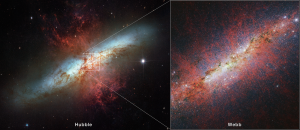 Margaret Carruthers leads a team of science writers and designers supporting the communications and public outreach mission of the Space Telescope Science Institute (STScI) on The Johns Hopkins University Homewood campus. “Every day I have the amazing opportunity to think about black holes, exploding stars, and an expanding universe,” she said. “Even after seven years, I am excited to go to work every day.”
Margaret Carruthers leads a team of science writers and designers supporting the communications and public outreach mission of the Space Telescope Science Institute (STScI) on The Johns Hopkins University Homewood campus. “Every day I have the amazing opportunity to think about black holes, exploding stars, and an expanding universe,” she said. “Even after seven years, I am excited to go to work every day.”
STScI was founded in 1981 to manage the science operations of the Hubble Space Telescope, which was launched on April 20, 1990. Margaret, who lives on the 1700 block of Bolton Street, noted that Hubble “is still going strong and actually working better than when it was first launched. Hubble has been serviced by astronauts five times and continues to provide really important scientific data. Hubble not only collects visible light, it is also the only observatory currently operating that can detect ultraviolet light.” A major advantage of space telescopes like Hubble is that their view is not impeded by Earth’s atmosphere, which blocks light from space.
Carruthers’ group collaborates with graphic designers, video producers, education specialists, software developers and astronomers on press materials, graphics, websites, videos and interactive presentations.
The mission of STScI expanded to include the science and mission operations of the James Webb Space Telescope, which was launched on Christmas Day, 2021. The Webb telescope conducts infrared astronomy and has provided spectacular and powerful images that are available on the web (https://webb.nasa.gov). Margaret said, “All the Hubble and Webb images are in the public domain and free to use by anyone.”
 STScI is involved in planning parts of the science operations for the Nancy Grace Roman Space Telescope, which will capture images of earthlike planets outside our star. It is planned to launch in 2026-27. “Dr. Nancy Grace Roman was the first NASA chief of astronomy and first female executive at NASA,” said Margaret. “She moved to Baltimore at age 12, was a graduate of Western High School and was an early advocate for the Hubble Space Telescope.”
STScI is involved in planning parts of the science operations for the Nancy Grace Roman Space Telescope, which will capture images of earthlike planets outside our star. It is planned to launch in 2026-27. “Dr. Nancy Grace Roman was the first NASA chief of astronomy and first female executive at NASA,” said Margaret. “She moved to Baltimore at age 12, was a graduate of Western High School and was an early advocate for the Hubble Space Telescope.”
Margaret added that an important mission of STScI is to help astronomers obtain data. The Barbara A. Mikulski Archive for Space Telescopes (MAST) curates and disseminates data from over 20 telescope missions which is publicly available after one year. It’s named for Maryland’s former U.S. Senator, an advocate for the space telescope program.
In addition to the science operations of the space telescopes, STScI is also in partnership with other NASA Missions. About 800 people work at STScI and, Margaret says, “It is such a pleasure working with so many brilliant and talented people doing really interesting things. Whenever you need an expert, they are here at STScI. Whether it is a research scientist or a graphic designer, they are here to help make the science accessible to the public.” Margaret recently worked as part of the team for the development of the Space Telescope Live website, a tool that shows where Hubble and Webb are looking in real time and provides information about the purpose of the observation.
Margaret, 52, grew up in Towson and obtained a B.S. from the University of the South and a masters from the University of Massachusetts Amhurst, where she studied the geology of Mars. She worked at the Museum of Natural History in New York City and in 2004 published The Hubble Telescope, a book for children explaining the Hubble Space Telescope mission. Her other books are Beach Stones and Pioneers of Geology.
“My background is in planetary science and science writing and education. I am so fortunate to have ended up back in Baltimore working for STScI. Finding new ways to present information is a challenge I enjoy, collaborating with the incredible people at STScI, and having access to its resources is incredibly rewarding.”
She is married to Richard Ash, a British geochemist at the University of Maryland. They have two children: Abigail, a freshman at UM-College Park, and James, who attends Poly high school.
–Sallye Perrin
